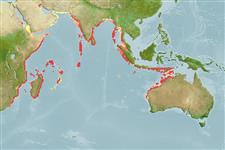>
Ovalentaria/misc (Various families in series Ovalentaria) >
Ambassidae (Asiatic glassfishes)
Etymology: Ambassis: Derived from Greek, anabasis = climbing up (Ref. 45335).
More on author: Lacepède.
Environment: milieu / climate zone / depth range / distribution range
Ökologie
seewasser; süßwasser; brackwasser demersal; ozeanodrom (Ref. 51243). Subtropical
Africa: Subtropical eastern South Africa to Kenya, Madagascar, Réunion and Mauritius (Ref. 50956).
Length at first maturity / Size / Gewicht / Alter
Maturity: Lm 5.0 range ? - ? cm
Max length : 15.0 cm SL Männchen/unbestimmt; (Ref. 52193)
Rückenflossenstacheln (insgesamt) : 8; Rückenflossenweichstrahlen (insgesamt) : 9 - 10; Afterflossenstacheln: 3; Afterflossenweichstrahlen: 9 - 11. Diagnosis: Ambassis ambassis has the following combination of characters: a single supraorbital spine; rostral spine absent; preopercle ridge and rear margin serrate; interopercle edge smooth except for few small serrae at angle; 2-3 rows of cheek scales; predorsal scales 13-18; lateral line continuous (normally); lower gill rakers 19-23; pectoral-fin rays 14-15 (Ref. 50956).
Tolerant of freshwater when water temperature is within 7-32°C (Ref. 7248, 79840). Tends to be more tolerant of lower temperatures in water of low salinity (2ppt) than in seawater (Ref. 7248). Feeds at night on crustaceans, fish fry and larvae and insects (Ref. 7248). Salt dried and eaten in some countries (Ref. 12484)
Life cycle and mating behavior
Geschlechtsreife | Fortpflanzung | Ablaichen | Eier | Fecundity | Larven
Fricke, R., 1999. Fishes of the Mascarene Islands (Réunion, Mauritius, Rodriguez): an annotated checklist, with descriptions of new species. Koeltz Scientific Books, Koenigstein, Theses Zoologicae, Vol. 31:759 p. (Ref. 33390)
IUCN Rote Liste Status (Ref. 130435: Version 2024-1)
Bedrohung für Menschen
Harmless
Nutzung durch Menschen
Tools
Zusatzinformationen
Download XML
Internet Quellen
Estimates based on models
Preferred temperature (Ref.
123201): 23.9 - 28.8, mean 27.3 °C (based on 254 cells).
Phylogenetic diversity index (Ref.
82804): PD
50 = 0.5000 [Uniqueness, from 0.5 = low to 2.0 = high].
Bayesian length-weight: a=0.01585 (0.00978 - 0.02569), b=2.98 (2.84 - 3.12), in cm total length, based on LWR estimates for this species & (Sub)family-body (Ref.
93245).
Trophic level (Ref.
69278): 3.7 ±0.56 se; based on food items.
Widerstandsfähigkeit (Ref.
120179): hoch, Verdopplung der Population dauert weniger als 15 Monate. (Preliminary K or Fecundity.).
Fishing Vulnerability (Ref.
59153): Low vulnerability (10 of 100).
